Olives and Olive Oil in Monotheistic Religions - Christian Faith
29-11-2024
17:04

The Baptism of Christ painting; a joint work of the student Leonardo Da Vinci and his master Andrea del Verrochio , 1472. Currently exhibited in the Uffizi Gallery in Florence. The work was commissioned by the priests of the San Salvi Church near Florence to be used on an altar.
The painting is a depiction of a moment of divine intervention; the soft blue sky and the misty landscape symbolize divinity and transcendence. The arms extending from the sky symbolizing God and the yellow light beams illuminate the son Jesus through the dove with outstretched wings, the messenger of the Holy Spirit; Fiat lux, let there be light, let the light of God be upon you. This image is accepted as a depiction of the Trinity/Holy Trinity.
Jesus is naked in the middle of the stage - except for his genital area covered by a loincloth - and above his head is a halo (a shining disk of light) symbolizing divinity and enlightenment in Eurasian geography art. All the characters in the work have halos, but only Jesus has a red cross on his halo. Red is the symbol of his suffering, sacrifice and connection to earthly life, in other words, his human side. Jesus is both fully human and fully divine, a belief called hypostatic union. The oldest existence in art history of the shining halo/sun disk depiction on his head symbolizing the sacred is the depictions of the ancient Egyptian male god Ra.
John the Baptist performs the purification ritual by pouring water from the bowl, he is wearing an earthy brown shirt; brown is usually associated with simplicity and giving up worldly goods; it is as if a reference is being made to his modesty, asceticism and John's role as a prophet living in the desert, but there is another detail that was only accessible to the noble and wealthy classes at the time the ritual took place and the work was made; the gold lacework on the edges of the robe, which is in the color of a pink. It is known that giving the fabric a black or brown color was an expensive practice in the Middle Ages, so it is difficult to think that the painter was really referring to simplicity and modesty when using these colors. There is a detail in the left arm of the robe , which is the symbol of loyalty, in blue - perhaps a shade of purple or indigo blue -. If we see the color as a shade of purple; we can say that it was an indicator of magnificence, sublimity, wisdom and sublime ideals, but indigo was one of the most expensive colors as a fabric dye in the Middle Ages. John holds in his left hand a thin cross and a scroll of paper on which is written the announcement of the coming of the messiah, "Behold the Lamb of God who takes away the sin of the world" from the Gospel of John.
Both of their feet are in a puddle of water - a sign of purification by water. The depiction of the feet in clear water so faithfully to their real appearance is worthy of special mention. The water comes from a river depicted in the background, the Jordan River. The rocks behind John, the trees on them and the puddle recall the archaeological site of El Maghtas (Arabic for immersion) east of the Jordan River. It is not known whether the artists of the work visited this site, but it is believed that this area was where Jesus was baptized. The depiction of the geological layers in the rocks behind is an indication of the master's sensitivity in depicting what he saw as close to reality as possible.
The two kneeling angels on the left side of the painting are considered to be the forerunners of the young Leonardo's painterly vision. Based on the details in the angel, authorities believe that this angel was colored by Leonardo. Jesus, who has long hair and more feminine features than the other, wears a dress with gold lace edges - apparently the same as John's . He watches the baptism with an innocent expression and an expression of admiration - a bit of contemplation. His clothes are dark black, at that time black was both an expensive color and a monastic color, and as a rule, fabrics saturated with color were more expensive than paler tones. If we assume the color of the angels' robes to be blue; in Christian iconography, blue and navy blue are often associated with the Virgin Mary. In the early Christian period, indigo was one of the most expensive colors, but towards the middle of the period it had to make way for the more expensive color of scarlet. Today, red is a sign of high rank in the monastic hierarchy. During those times, the Virgin Mary was almost always depicted wearing navy blue. If we accept that it is a shade of purple, we can make a different interpretation. Considering that purple robes became a color worn by priests, kings, emperors and judges in the Middle Ages, it can be said that there is a reference to the concept of spirituality and power. The "Imperial purple" obtained from the small sea snail with a shell (nucella lapillus) was more expensive than gold. Approximately 10,000 sea snails with shells were used to obtain just 1 gram of color. The dark, intense purple dye made from this snail is known as Tyrian purple, and due to its crazy price, it was an indicator of royalty.
The other angel, whose facial expression is depicted as more masculine than the other, has his hands clasped over his chest, there is no admiration in his facial expression, he is looking in another direction. It is not known who or what he is looking at, as if he has an expression of some discomfort. There are suggestions that he is looking towards others who are not in the picture but are watching the baptism ritual.
The tree behind the angels is the palm tree, which is characteristic of the Mediterranean geography and the region of the Euphrates and Tigris rivers. Palm trees are the symbol of male gods in Ancient Egypt, ancient goddesses in Anatolia and the Middle East, and Nike, the goddess of victory, for the Roman people. According to the Gospel of John from the Canonical Gospels, when Jesus and his followers descended from the Mount of Olives to Jerusalem on a donkey, a symbol of peace and humility, the people covered the road with the branches of this tree to honor him; palm branches became the red carpet for the poor people. The Feast of Branches, celebrated on the Sunday before Easter, celebrates Jesus' entry into the city as a victorious hero, and tree branches are used. In the regions where the Christian faith has reached but palm trees are not available, olive branches are used in celebrations, and since neither tree grows in more northern regions, branches of any local tree are used.
Ornithologists believe that the other two dark-coloured birds in the work (one of which is depicted in barely visible silhouette within a palm tree) are male red-backed shrikes; their symbolic meaning is unknown, with one interpretation being that they symbolise the devil.
At the right elbow of Jesus, there is a bird that is almost invisible, probably a pelican. The pelican was popularized in medieval Christian art as a symbol of Jesus' sacrifice. This is because it is believed that when a mother pelican is not hunting, she pecks her own flesh and feeds her young with the blood she sheds, symbolizing Jesus' self-sacrifice and sacrifice. It is also linked to the sacrament of Holy Communion, as it contains a reference to Jesus' words, "This is my blood, shed for you." Jesus is referred to as the "good pelican" in the hymns of the theologian philosopher of the period, Thomas Aquinas.
In the first chapter of the Gospel of John, John tells the Jewish elite that he is not the messiah, but that the messiah is Jesus, and why he believes this. "...John continued his testimony as follows: I saw the Spirit descending from heaven like a dove and standing on Him. I did not know Him. But He who sent me to baptize with water said, 'On whomever you see the Spirit descending and standing, it is He who baptizes with the Holy Spirit.'"
The most fundamental belief of Christian consciousness is the Trinity. The Trinity is a complex belief system that defines the triune unity of God, expressed as Father, Son and Holy Spirit. According to Christian thought, the element that God used to impregnate the virgin Mary, the mother of Jesus, is called the Holy Spirit. The manifestation of the soul as a bird is also frequently found in Turkish epics, stories and legends. It is described as “shape changing/changing skin” in Uyghur legends. Especially during their journeys to the sky, shamans take the form of a bird, which actually represents the “human soul”, or ride a supernatural animal. With the acceptance of Islam by the Turks, “changing skin” began to be described as the miracles of saints or saints.
In the temples and tombs of the early Christians of the Roman period, which were carved into rocks or dug underground to hide or avoid investigation, depictions of a dove returning with an olive branch in its mouth can be found. The dove with an olive branch in its mouth has been depicted in many churches as a symbol of holiness. In the early periods of Christianity, the dove was seen as a symbol of baptism. The olive branch is also a symbol of the Holy Spirit, and iconographically, the resurrection after death, and the dove carrying the olive branch was used as a symbol of “the harbinger of new life” referring to the flood myth.
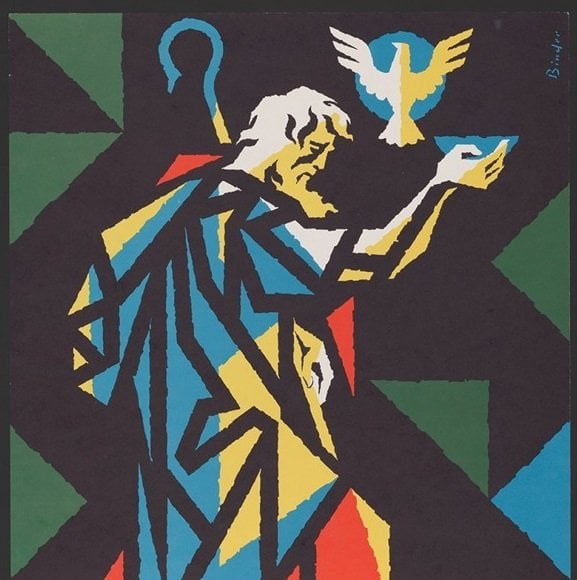
John the Baptist; a drawing by the Austrian designer and painter Joseph Binder (1898-1972), from the collection of Biblical Images (1962).
In the history of Christian painting, depictions of winged humans instead of doves are also encountered. There are many paintings under the title "The Dream of St. Joseph", which are about St. Joseph (The Virgin Joseph), who according to some was the fiancé/protector of the Virgin Mary and according to others was her husband who never had sexual intercourse with her.
In the history of Christian painting, depictions of winged humans instead of doves are also encountered. There are many paintings under the title "The Dream of St. Joseph", which are about St. Joseph (The Virgin Joseph), who according to some was the fiancé/protector of the Virgin Mary and according to others was her husband who never had sexual intercourse with her.
The common point of most stories related to beliefs originating from the Middle East is the Mount of Olives east of Jerusalem. Noah's dove brought an olive branch from this hill, from where the Messiah would come. Jesus ate his last meal at the foot of this mountain and ascended to heaven from here. It is believed that he rested under the old olive trees there. It is said that the eight olive trees on the Mount of Olives witnessed the crucifixion of Jesus and that the cross on which Jesus was crucified was made from an olive tree that grew from Adam's grave. Those in the cemetery at the foot of the mountain are the first elite to be resurrected when the apocalypse comes. The ancient image of the "sacred mountain where the gods live" has now transformed into the hilltop area where the olive tree is located in the consciousness of the people of the Middle East. In the Canonical/Religious Authorities Accepted Gospels (Matthew, Mark, Luke, John) it is narrated that Jesus spent time on this mountain, especially in the evenings, and chatted with his apostles (first disciples) here.
Paul, a religious man of Jewish origin, was the first missionary to spread the sermons and teachings of Jesus among the polytheistic Roman people. In the "Letter to the Romans" section of the Bible, Paul preaches through the olive tree that the Jewish and Christian faiths are one in origin, and according to him, Christianity is a version of the Jewish faith that has been re-grafted onto the trunk:
“…If the first piece of dough is holy, then the whole dough is holy. If the root is holy, then the branches are holy. But if some branches of the olive tree are cut off and you, as a wild olive shoot, are grafted in their place and become a partaker of the healthy root of the true tree, do not boast about the branches. If you boast, remember that you do not bear the root, but the root bears you. Then you will say, “The branches were cut off so that I could be grafted in.” It is true that they were cut off through unbelief, but you stand firm through faith. Do not boast, but be afraid. For if God did not spare the original branches, he will not spare you. Therefore see the goodness and severity of God. He is severe to those who fall, but if you remain firm in his goodness, he will deal kindly with you. Otherwise, you too will be cut off. If they do not persist in unbelief, the Jews too will be grafted back into the true tree, for God has the power to graft them back in. If you were cut off from the wild olive tree and grafted into the true olive tree against nature, then the true branches will be cut off from the true olive tree.” How much more will they be grafted in!” (Romans 11:16-24).
These statements may have been made to Jewish people who did not accept that Jesus was the messiah at that time, but they may also have been used to attract pagans or non-Jewish members of the community who were inclined to monotheism and were not accepted by the Jewish community to the Christian faith.
In the early days of Christianity, among the pagan people in the city of Rome, polytheistic religious beliefs (paganism) of Egyptian and Greek origin were widespread. According to the Romans, the dove was the symbol of the feminine fertility energy and Venus (Aphrodite in Greek myths). Hermes, the son of Zeus, who acted as an intermediary between the gods and humans in Greek myths, was a male god with dove wings on his feet and on his helmet in the minds of the people with pagan beliefs. It is also known that in ancient Egypt, in the designs of life after death, a soul called “Ba”, which could take on various forms, was envisioned as a bird. This historical background has led to the interpretation that pagan beliefs were not completely erased from the collective Christian subconscious, but continued their existence under new names by changing shape.
The pigeon, depicted as a bird that brings abundance and prosperity, is associated with the first Turkish khan to accept Islam, Satuk Buğra Khan, and his tomb. In Uyghur legends, the pigeon is associated with the Prophet Muhammad and Satuk Buğra Khan. The pigeon is also sacred to Muslims because it prevented the infidels from capturing the Prophet Muhammad.
The term "messiah", which is frequently used to emphasize the holiness of Jesus, etymologically comes from the verb "to anoint" or "to rub with oil". The belief that being rubbed with oil is an indicator of holiness is a very ancient idea that existed in that geography. There is a female figure anointing Jesus in all the Gospels. The story of oil (neonate oil or olive oil) brought in a container made of alabaster is told. In one of the Gospels, the woman who brings the oil puts the oil on Jesus' feet and rubs it through her hair, and in the other, she pours the oil from his head. While pouring the oil from his head brings to mind the Jewish faith on the one hand, on the other hand, it is similar to the ritual of water baptism with oil. It is striking that in the Gospel, instead of God or the Priest King as in Judaism, the person pouring the oil is an ordinary person - even a sinful woman (the repentant prostitute Maria Magdalene) according to one of the Gospels. In the Gospels of Matthew and Mark, Jesus says that he is preparing to be buried with the oil poured from his head. This statement suggests that the tradition of rubbing the corpse with olive oil or sprinkling oil on it, which was common among the ancient Greek and Roman peoples, was not lost.
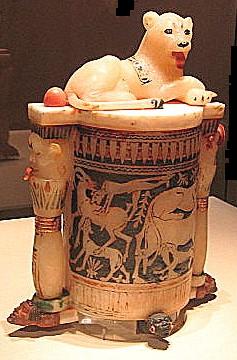
Plaster cosmetic jar with lioness symbol of the Egyptian goddess Bastet, an Eighteenth Dynasty grave good from the tomb of Tutankhamun (c. 1323 BC), Cairo Museum.
When we look at the etymology of alabaster, we understand that its origin goes back to a word that refers to the containers of the ancient Egyptian lioness/cat-headed goddess Bastet (Lady of the Ointment Jar). This goddess, who was the daughter of the sun god Ra at the top of the hierarchy, was the protective goddess of the women and children of the house, and it was believed that she protected them from diseases with the ointments she made. It is thought that the first area of use of oils and ointments in ancient times was religious rituals. Ointments were placed in white marble containers in front of the statues of the gods, and the priests would take it with their fingers and apply it to the statue. Over time, ointments began to be used for purposes other than religious purposes, the earliest examples of which were found in Ancient Egypt, and noble and wealthy upper-class Egyptians began to use these ointments for themselves and their funerals. It is thought that ointments made from oils that retained their scent, such as olive oil, almond oil and sesame oil, were used, and salt was added to prevent spoilage. The ancient cosmetics applied to the skin by massaging must have provided elasticity and softness to the skin in the sunny climate of Egypt. The story above, which also brings to mind the behavior of cats rubbing against human feet, is like a myth of the process of people with pagan beliefs repenting and becoming Christians when they encountered the Christian faith.
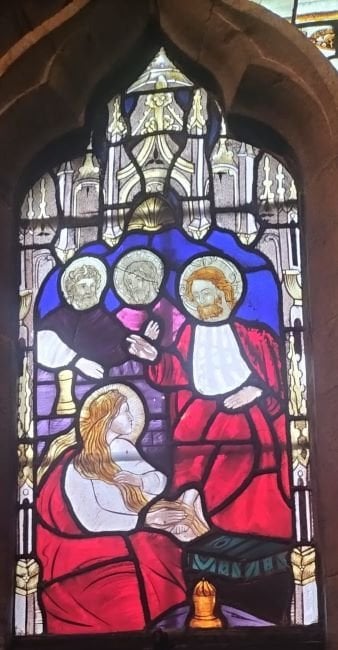

Mary Magdalene rubs Jesus' feet with her hair, carrying a jar of oil. Window of St. Edmund's Catholic Church, Southampton, England, photo: Ella Rozett
Women named "Mary" mentioned in the stories in the Bible have always had a special relationship with Jesus. The name of his virgin mother is Mary. In the Gospel of John, the long-haired woman who comes with a vessel of oil in her hand, falls at Jesus' feet and rubs his feet with oil - as if the Goddess anoints him and makes him the chosen one - and then repents and becomes a Christian is Mary Magdalene. The same Mary is next to him when he is crucified and killed, and again according to the Gospel of John, the first person to witness his resurrection is Mary Magdalene - who thought he was a gardener when she first met him.
One of the passages in the Gospel of Matthew that is related to olive oil and women is the story of the ten virgins waiting for Jesus. Jesus is late, it is night time and the virgins have fallen asleep. When they hear that Jesus is coming, they all wake up, but the oil in the lamps (olive oil was very common as a source of illumination at that time) has run out. Five of them, who had foreseen this, put on their spare oil, light their lamps and go out to greet Jesus. The others who went to get oil were late, could not greet Jesus and could not enter the wedding feast; "...The virgins who were ready went with him into the wedding feast, and the door was closed. The other virgins who came later said, 'Lord, Lord, open to us!' But the bridegroom (Jesus, the one who was about to be married) said, 'I tell you the truth, I do not know you.' Therefore stay awake, for you do not know that day or that hour..." Matthew 25, 1-13. There are different interpretations of what the expressions in these verses are referring to.
During the time of the Jewish cleric Paul, the worship of the mother goddess Isis, whose historical origins go back to ancient Egypt, was very widespread in the Greco-Roman world. Isis temples first became widespread in Syria around 700 BC, and then three hundred years later, in mainland Greece and the Mediterranean coastal cities. In the first century BC, Isis worship was a popular belief that spread throughout Western Europe, especially in Rome, as a mystery cult. Around 430 AD, the Christian theologian Proclus gave a sermon attributing divinity to Mary, calling her an intermediary between God and man. In a sermon in Ephesus, Cyril of Alexandria almost deified Mary, so that Isis and her counterpart, the Ephesian mother goddess Diana (Artemis), seem to have been transformed into the holy virgin Mary in the consciousness of the people of the period. There is also a Christian belief that Mary's tomb is on a hill in the ancient city of Ephesus.
It is known that confession rituals were performed in Isis temples as well as in Christian churches. The basis of the confession practice in Christianity seems to be the following statements in the Bible; "You did not anoint my head with oil, but this woman anointed my feet with sweet oil, therefore I tell you that her many sins are forgiven." (Luke 7:46).
The ritual of purification with water was also common among peoples with pre-Christian polytheistic pagan beliefs. In archaeological excavations carried out in Western Anatolia and Greece, vessels/boats/bowls used for purification and purification with water at the entrance before entering the temple were found. It is present in the texts written by writers of the period that a green-branched plant -probably olive or laurel- was used to sprinkle water before entering the sacred area. In the baptismal ceremony, the priest in Isis temples says the following; "I cleanse you with water and I cleanse you with oil." Because during Isis rituals, it was believed that by baptism or pouring the holy water of the Nile over the head of the worshipper, all his sins would be erased and he would be free from his mistakes. Although the worship of the Egyptian mother goddess Isis, who was believed to be the god who created the olive tree by the Egyptian people, seems to have been transferred to Christianity, the baptismal ritual in Christianity is different from the Isis rituals. In Christianity, baptism is done once, a ritual of purification with water is not performed at every entrance to the church, and none of the actions associated with washing/cleansing that remind us of pagan beliefs are similar to the symbolic rebirth and spiritual enlightenment that occur in baptism. In the early periods of Christianity, the baptism ritual could be performed in the sea, river, water source, lake or a smaller pond. Later, this ritual began to be performed in baptisteries located right next to the church.
The Book of Jacob, Chapter 3, is like a sermon on the importance of speech and words coming out of the mouth under the title of unbridled tongue. It brings to mind the Bektashi proverb "control your hands, your waist, your tongue" to the reader. Praise and curse should not come from the same tongue, this is impossible, this idea is tried to be expressed with the expression "...can a fig tree bear olives or a vine bear figs?"
The phrase "These are the two olive trees and the two lampstands standing before the Lord of the earth" in Revelation 11 (The Two Witnesses) verse 4 brings to mind the two actors in the Old Testament book of Zechariah, chapter 4, "The Fifth Vision: The Lampstand and the Olive Trees." The two witnesses (two chosen ones) to whom God has given power are compared to the olive tree and the lamp. The people who harm these two prophets are punished.
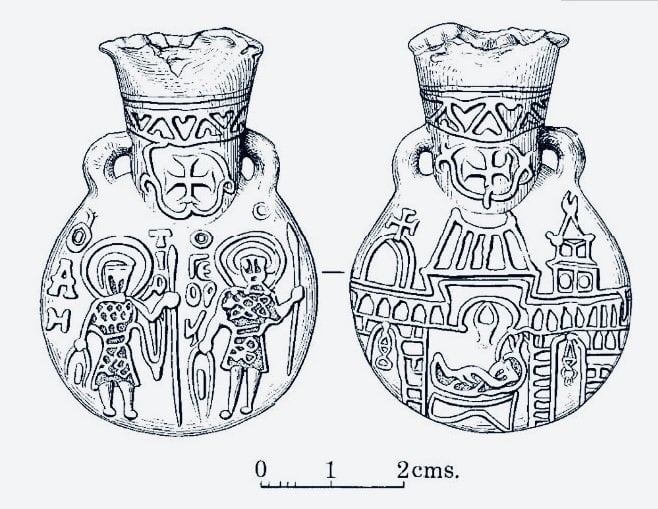
The tradition of anointing was eventually applied to the coronation ceremonies of European monarchs and to the anointing of the newly elected pope. In England, holy cream was applied to the hands and palms of priests in rituals performed for newly appointed priests. In literature, it is also possible to come across the anointing of the church and objects within the church. Such areas of use of holy oil, other than the rituals of baptizing the soul and preparing for death, are probably the continuation of religious practices described in the verses in the Old Testament. The culture of rubbing and blessing many objects, including objects in temples, with olive oil or a product referred to as "holy oil" mentioned in the Old Testament has not disappeared and has been transferred to the Christian church culture and continues to exist as a culture applied in our age.
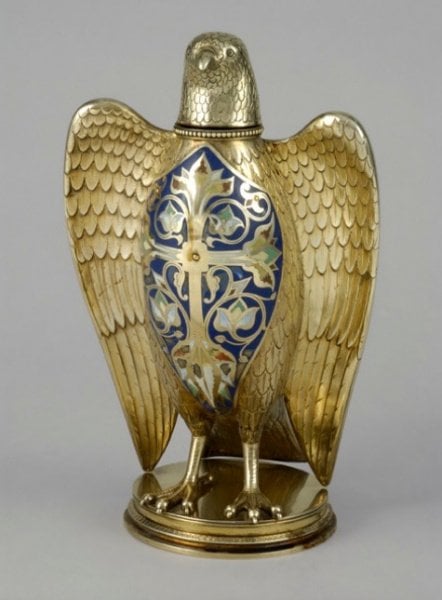
Photo; Birmingham light bulb , a contemporary ampulla designed in the shape of a dove, symbol of the Holy Spirit, containing holy chrysm (blessed essential oil), gilded with 24-karat gold leaf, the dove's lapis lazuli eyes hand-carved, with the Birmingham diocese's coat of arms on the front, manufactured by New Guild Studio Inc., the anointing oil is sanctified by the Rite of Chrysm (the Rite of the Holy Oil) performed on Holy Thursday/Lord's Supper Thursday, and is used in Episcopal ordinations, Priesthood Ordination, Baptisms and Confirmations. ( source ). Compiled by: Uğur Saraçoğlu ( ugisaracoglu@yahoo.com.tr )
Some of the sacrament rituals, which are an important religious practice for the Christian faith, use pure olive oil with essence and balsam (tree gum). This mixture, called "chrism" in English, is made by senior priests (bishops) or authorized priests with prayers, in a kind of ceremony at a certain time of the year, and is placed in containers and stored in containers. The word is used in the sense of "myrrh", "miron", blessed oil or holy anointing oil. Its etymological origin goes back to the ancient Greek word myrrh (fragrant oil). Again in ancient Greek, "khrisma" refers to the act of anointing. Over time, the word evolved into the Latin form "cramum", and then, through the French-speaking peoples, it seems to have reached the English people and turned into the word "cream". In the language of the Assyrian community, one of the peoples of the eastern geography, the term "murun" is derived from the word muro, meaning the gum of the pleasant-smelling tree used to embalm the dead.
The word sacrament in Christian literature refers to religious ritual practices performed by priests that sanctify those who are believed to be/will be Christians, in other words, seal them as Christians. The holy ointment, one of the materials in the ritual, appears as an object that is a symbol of the holy spirit in the consciousness of believers.
The word sacrament in Christian literature refers to religious ritual practices performed by priests that sanctify those who are believed to be/will be Christians, in other words, seal them as Christians. The holy ointment, one of the materials in the ritual, appears as an object that is a symbol of the holy spirit in the consciousness of believers.
Catholic consciousness perceives the sacraments as symbolic expressions or reenactments of the goodness that God/Jesus Christ has done for humanity (education, service, healing, feeding the hungry, forgiveness, suffering...). Although the etymological origin of the word can be traced back to the ancient Greek language, in terms of meaning it is the making visible of an invisible divine goodness or the theatrical re-presentation of a sign specific to God.
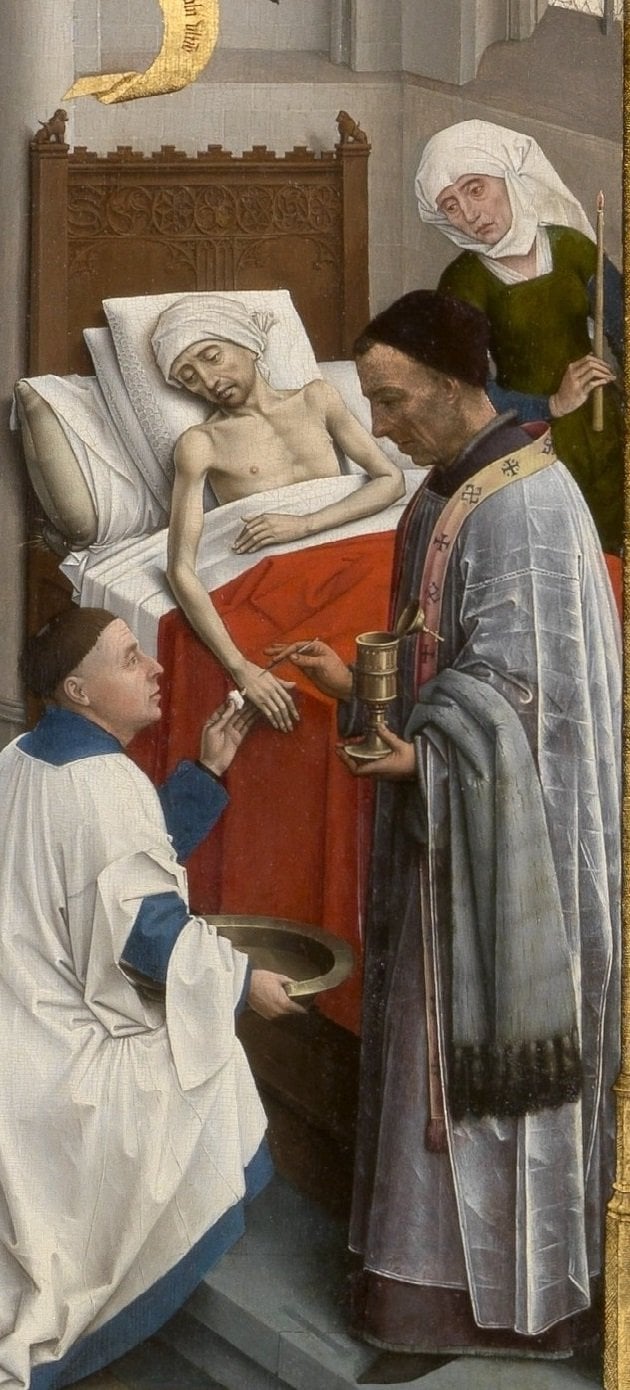

Detail from the painting "Altar of the Seven Sacraments" . A senior priest standing (probably the bishop of the church) holds a jar of holy oil and drops a drop of holy oil from the jar onto a white cloth in the right hand of another priest in white, who is kneeling. The tray in the kneeling priest's right hand is used to prevent the holy oil from spilling onto the floor. This oil painting, executed on a foldable panel divided into three sections with fixed wings, was completed by the Dutch artist Rogier van der Weyden and his workshop over five years. The entire work depicts the seven sacraments (sacraments) of the Roman Catholic Church and is currently on display in the Royal Museum of Fine Arts in Antwerp, Belgium.
One of the seven sacraments performed in Catholic Christian communities is the "last anointment - the anointing of the patient on his deathbed." The origin of this practice is based on the following statement in the Bible; "If anyone among you is sick, call the elders of the church, and let them anoint him with oil in the name of the Lord and pray over him." James 5:14. However, the origin of this form of worship is not only related to the Bible, it is probably also related to the ancient Roman religious practice of anointing the body before burial.
One of the seven sacraments performed in Catholic Christian communities is the "last anointment - the anointing of the patient on his deathbed." The origin of this practice is based on the following statement in the Bible; "If anyone among you is sick, call the elders of the church, and let them anoint him with oil in the name of the Lord and pray over him." James 5:14. However, the origin of this form of worship is not only related to the Bible, it is probably also related to the ancient Roman religious practice of anointing the body before burial.
Catholics perform this ritual only on Christians who are about to die. Olive oil ointment/cream is applied to the person's hands, forehead or face for the purpose of healing or for the forgiveness of sins, thus trying to ensure a peaceful death process. The priest who takes part in the ritual is like playing the role of Jesus, when it is performed for the purpose of healing, the priest appears to take on the identity of a doctor, but it is believed that the power of the ritual comes from God, not the priest. The priest places his hand on the patient, prays for the patient and then rubs the person's body, especially the face and hands, with the blessed oil in a certain order. If the patient does not die after the ritual or gets better but gets worse again later, the ritual is performed again. Orthodox Christians perform this practice not only on the dying person but also on the patients and as a precaution against catching the disease. There is much debate in Christian history about whether the power of this ritual comes from the believer's faith, God or the clergyman.
In some Orthodox churches (Armenian and Assyrian), there is another anointing ritual performed immediately after the baptism ritual performed with water for newborns or those who later converted to Christianity; "Sacrament of the Murun". The body is baptized with water, but the spirit cannot. With this sacrament - a type of complementary baptism - performed immediately after the ritual in which water is used, the spirit is also baptized and the union of body and spirit is established. The body of the newborn is marked by being rubbed with sacred anointing oil and is deemed worthy of God's grace. Some of the verses shown as the origin of this idea and belief are as follows;
"He who establishes us together with you in Christ and anoints us is God. He has sealed us and placed the Holy Spirit in our hearts as a guarantee."
2 Corinthians 1, 21-22.
"... you know how God anointed Jesus of Nazareth with the Holy Spirit and with power..." Acts 10, 37-38.
The essential oil, which is blessed ceremonially by senior priests, is kept in containers in the church. Over time, the holy oil - probably because it is easy and practical to carry - is placed in small glass or metal containers in the shape of a bulb and brought into a shape that the priest can carry with him; in the literature, these containers are called "sacred ampulla".
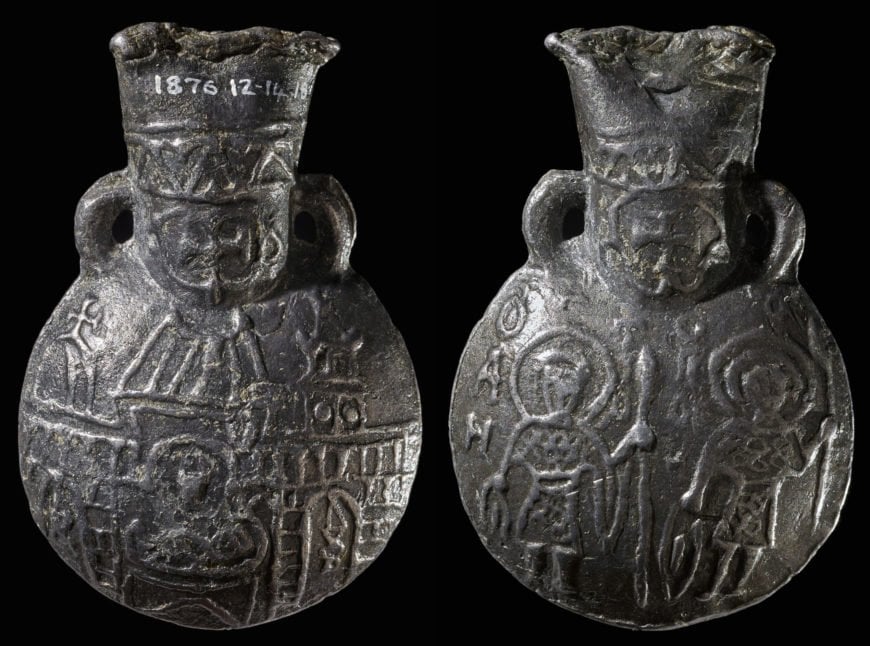
The essential oil, which is blessed ceremonially by senior priests, is kept in containers in the church. Over time, the holy oil - probably because it is easy and practical to carry - is placed in small glass or metal containers in the shape of a bulb and brought into a shape that the priest can carry with him; in the literature, these containers are called "sacred ampulla".

Photo; Lead Pilgrimage Ampoule , used to carry holy oil, 12th to 13th century (Middle Byzantine period), Made in Jerusalem, Height: 56.60 mm, Width: 37 mm, Depth: 15.60 mm.
There are crosses on both sides of the neck. The new appearance of the Church of the Holy Sepulchre in Jerusalem after the reconstruction carried out by the Crusaders is depicted on the side of the ampulla that contains architectural depictions . The additions made during that period can still be seen today. The three-arched church, believed to be the place where Jesus was crucified, buried and resurrected, is decorated in relief. On the right and left of the structure, two structures added during the Crusader period are depicted; a bell tower and a large dome with the Crusader symbol on it. It is believed that the body of Jesus is in a coffin under the middle arch (Anastasis Rotunda; the domed architectural structure above the place where Jesus is believed to be buried). A lamp is hung under each of the three arches. An attempt is made to tell the story of the past in the Bible and the period when the Crusaders conquered Jerusalem together.
On the back of the ampulla, there are two depictions of soldier saints, each holding a spear in their left hand and a shield in their right hand, with the names of the saints written on their right sides; Dimitri and George. The following comment has been made about the depictions on the ampulla; the saints who reconquered Jerusalem were on the one hand proud of their success and on the other hand proud of the rebuilding of the holy temple, and every time they looked at the ampulla - symbolizing the past and the successes of the period in the Bible - they felt as if they were personally experiencing the moment of Jesus' burial and resurrection through this depiction .

The tradition of anointing was eventually applied to the coronation ceremonies of European monarchs and to the anointing of the newly elected pope. In England, holy cream was applied to the hands and palms of priests in rituals performed for newly appointed priests. In literature, it is also possible to come across the anointing of the church and objects within the church. Such areas of use of holy oil, other than the rituals of baptizing the soul and preparing for death, are probably the continuation of religious practices described in the verses in the Old Testament. The culture of rubbing and blessing many objects, including objects in temples, with olive oil or a product referred to as "holy oil" mentioned in the Old Testament has not disappeared and has been transferred to the Christian church culture and continues to exist as a culture applied in our age.

Photo; Birmingham light bulb , a contemporary ampulla designed in the shape of a dove, symbol of the Holy Spirit, containing holy chrysm (blessed essential oil), gilded with 24-karat gold leaf, the dove's lapis lazuli eyes hand-carved, with the Birmingham diocese's coat of arms on the front, manufactured by New Guild Studio Inc., the anointing oil is sanctified by the Rite of Chrysm (the Rite of the Holy Oil) performed on Holy Thursday/Lord's Supper Thursday, and is used in Episcopal ordinations, Priesthood Ordination, Baptisms and Confirmations. ( source ).
Source:
1. Baptism and Confession Rituals in the Isis Cult as Rituals Transferred to Christianity, Kürşat Haldun Akalın, Atatürk University Faculty of Theology Journal, Issue: 42, Erzurum 2014.
2. The Return of Isis, Queen of the Sky: Worship of the Virgin Mary in Christianity, Kürşat Haldun Akalın, İLTED, Erzurum 2016/1, Issue: 45, pp. 81-107.
3. Middle Eastern Mythology, Mesopotamian, Egyptian, Palestinian, Hittite, Jewish, Christian Myths, Samuel Henry Hooke, Translated from the original English by Alaeddin Şenel, İmge Bookstore, 1991.
4. Some Medicinal Plants and Their Myths; Compilation, Nilay Tarhan, Miray Arslan, Sevgi Şar, Lokman Hekim Journal, 016;6(1):1-9.
5. Iconography of a Unique Stone House in Turgutreis Akyarlar – Fish, Pigeon, and Tree of Life – Article, Amisos, Volume 3, Issue 4 (June 2018), pp. 90-109.
6. Pagan Roots of the Christian Trinity, Mehmet Zafer İnanlar, Journal of Theological Studies, Issue 13, June 2020, Article: 131-152.
6. 22. https://mersin.edu.tr/haberler/327428/nagidos-antik-kenti-kazilari.
7. History of Religious Beliefs and Thoughts, Volume II, From Gautama Buddha to the Birth of Christianity; Mircae Eliade, 1976, Translator: Ali Berktay, Kabalcı Publishing House, 2000.
8. Religious Water Beliefs in the Late Antique and Early Christian World; Selda Uygun Yazıcı, Anadolu University, Faculty of Letters, Department of Art History, Journal of Trakya University Faculty of Letters, Volume: 8 Issue: 16, July 2018, pp. 21-31.
9. https://en.wikipedia.org/wiki/Bastet.
10. https://en.wikipedia.org/wiki/Alabaster.
11. The Symbolic Meaning of the Palm and Its Reflection in Ancient Art, Banu Yılmaz, Pamukkale University, Faculty of Arts and Sciences, Department of Archaeology, Kınıklı Campus, Denizli.
12. The flight of the shrike. The ornithological representation in the Baptism of Christ (1470-1475 c.) by Andrea del Verrocchio and Leonardo da Vinci, Marco Masseti, Dipartimento di Biologia dell'Università di Firenze, Via del Proconsolo 12, 50122 Firenze, Italia.
13. https://www.uffizi.it/en/artworks/verrocchio-leonardo-baptism-of-christ.
14. The Symbol of Repentance in Christian Art: Mary Magdalene, Res. Asst. Şule Gedikli, Ankara Hacı Bayram Veli University, Faculty of Letters, Department of Art History, Academic Journal of Social Research, Year: 7, Issue: 98, November 2019, pp. 198-216.
15. https://tr.wikipedia.org/wiki/El-Ma%C4%9Ftas.
16. https://www.bbc.com/culture/article/20210623-the-halo-a-symbol-that-spread-around-the-world.
17. https://www.karinatarin.co.uk/blog/the-origins-of-the-halo-in-art.
18. https://tr.wikipedia.org/wiki/Dallar_Bayram%C4%B1#:~:text=Dallar%20Bayram%C4%B1%20or%20Christ%20will%20enter%20Eru%C5%9Falim%20victoriously.
19. https://kutsalkitap.info.tr/?q=Yu.1.
20. https://artvee.com/dl/st-john-the-baptist/.
21. https://www.worldhistory.org/trans/tr/1-15010/bastet/ .
22. https://www.interfaithmary.net/articles/marymagdalene .
23. https://dergipark.org.tr/tr/download/article-file/643288 .
24. Sacraments in Protestantism, Assoc. Prof. Dr. Muhammet Tarakçı, Emin Publications, Bursa 2012.
25. https://en.wikipedia.org/wiki/Chrism .
26. https://dergipark.org.tr/en/download/article-file/1716375?utm_source=chatgpt.com .
27. https://www.catholic.com/encyclopedia/chrism .
28. https://en.wikipedia.org/wiki/Chrism .
29. https://www.newliturgicalmovement.org/2022/06/a-new-chrism-ampulla-for-birmingham.html .
30. https://www.worldhistory.org/trans/tr/1-19816/ra-misir-tanrisi/ .
31. https://www.bbc.com/culture/article/20180801-tyrian-purple-the-regal-colour-taken-from-mollusc-mucus .
32. https://www.worldhistory.org/trans/tr/1-14999/tyrian-moru/ .
33. https://en.wikipedia.org/wiki/Tyrian_purple .
34. https://www.thetorah.com/article/colors-of-holiness-clothing-the-high-priest-to-match-the-tabernacle .
35. https://en.wikipedia.org/wiki/Chrism_Mass .
22. https://www.interfaithmary.net/articles/marymagdalene .
23. https://dergipark.org.tr/tr/download/article-file/643288 .
24. Sacraments in Protestantism, Assoc. Prof. Dr. Muhammet Tarakçı, Emin Publications, Bursa 2012.
25. https://en.wikipedia.org/wiki/Chrism .
26. https://dergipark.org.tr/en/download/article-file/1716375?utm_source=chatgpt.com .
27. https://www.catholic.com/encyclopedia/chrism .
28. https://en.wikipedia.org/wiki/Chrism .
29. https://www.newliturgicalmovement.org/2022/06/a-new-chrism-ampulla-for-birmingham.html .
30. https://www.worldhistory.org/trans/tr/1-19816/ra-misir-tanrisi/ .
31. https://www.bbc.com/culture/article/20180801-tyrian-purple-the-regal-colour-taken-from-mollusc-mucus .
32. https://www.worldhistory.org/trans/tr/1-14999/tyrian-moru/ .
33. https://en.wikipedia.org/wiki/Tyrian_purple .
34. https://www.thetorah.com/article/colors-of-holiness-clothing-the-high-priest-to-match-the-tabernacle .
35. https://en.wikipedia.org/wiki/Chrism_Mass .
